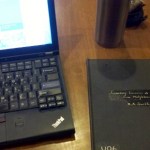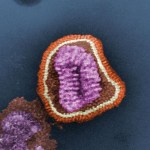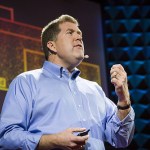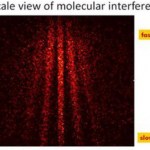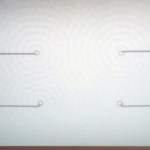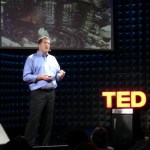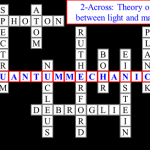Science
The ongoing mess over Bora Zivkovic's harassment of women writers in connection with his editorial role at Scientific American and Science Online has moved into the "What is to be done now?" phase. The most prominent and linkable of these are from Maryn McKenna and Kelly Hills, though I've also seen the edges of more ephemeral discussions on Twitter. Much of this has focused on formal organizational changes, stripping Bora of power and titles and banning him from the conference. These are entirely appropriate, though partly moot given that he's resigned from both Scientific American and…
Yes, that's another TED@NYC picture as the "featured image," but don't run away! It's a post about science, I swear!
The photo up above is from the Flickr set (which, by the way, has been edited significantly since yesterday...), and I like it a good deal. Mostly because, as the joking caption suggests, that photo of Max Planck looming over my head has a kind of serial killer vibe to it. But here's the thing: this is the original phtoo that's on the slide:
Max Planck around the time he solved the black-body radiation problem. From wikimedia.
It's a black-and-white photo from 1901, and in…
As noted in a previous post on Monte Carlo simulation in 1960, we recently came into possession of a large box of old Master's theses. The bulk of these are from the 50's and 60's, but there are some going back much farther. As I pass these every day I'm in the office, I thought it might be amusing to take a look at these for the blog, now and again. I don't plan to do a detailed examination of the quality of the science (at least, not necessarily), but to use this to look at how things have changed over the decades.
The first of these, pictured above, is one of the oldest: Secondary Emission…
The Twitter conversation that prompted yesterday's post about composite objects was apparently prompted by a comment somebody made about how a virus left alone would see its quantum wavefunction spread out on a time scale of minutes. This led to wondering about whether a virus could really be considered a particle that would move as a single quantum unit, and then to whether that estimate is reasonable. So, let's look at that specific question a little more closely. This is going to be one of those swashbuckling physicist estimation deals, in which I'm going to attempt to come up with numbers…
Back in July, Physics Today ran an article on Reinventing physics for life-sciences majors (I couldn't find an un-paywalled version, but this arxiv preprint seems to be close to it). As I've had some bad experiences with that class, I flagged it as something to read, but only got around to it last night. The main idea is that a "Physics for Life Sciences" course needs to be arranged around the way biologists think, which is fundamentally different than the way physicists think:
In general, physicists stress reasoning from a few fundamental principles—usually mathematically formulated—and seek…
The nice folks at TED have put up a giant Flickr set of pictures from last week's event. I'm not sure it's complete, but I happened to notice it this morning, and it already had several pictures of me in it, which is all I really care about. I particularly like the "featured image" above, which kind of makes me look like some kind of quantum demagogue urging my electrons on to more efficient production of interference patterns like the one over my shoulder.
But I also like this one, in which a deranged Max Planck looms behind me like a serial killer:
Max Planck knows what I did last summer…
I'm doing a bit of work on an idea for physics outreach, which would involve tying a discussion of modern physics to science fiction stories. I have Opinions about this sort of thing, of course, but I also have readers who might think of things I don't. So, let me throw this out to you all:
What is your favorite example of a science fiction story (here meaning print, movie, or television) making use of ideas from quantum physics? What's your least favorite?
My favorite stories invoking QM ideas are probably Robert Charles Wilson's brilliant "Divided by Infinity" (which I will draw heavily on…
Through some kind of weird synchronicity, the title question came up twice yesterday, once in a comment to my TED@NYC talk post, and the second time on Twitter, in a conversation with a person whose account is protected, thus rendering it un-link-able. Trust me.
The question is one of those things that you don't necessarily think about right off-- of course an atom is a particle!-- but once it gets brought up, you realize it's a little subtle. Because, after all, while electrons and photons are fundamental particles, with no internal structure, atoms are made of smaller things. But somehow we…
Over the weekend, before the whole Scientific America debacle blew up, Ben Lillie tweeted:
Looking for science news pegs that aren't "a paper was published." Good examples? #ScioOcean #scionew
— Ben Lillie (@BenLillie) October 12, 2013
This is, of course, a familiar problem to a lot of people who care about the public dissemination of science. The need for a good "hook" is a constant issue, because without one, you can't get anyone to pick up a story. And you can't let one get past, either, leading to a frantic scramble whenever anything happens that has the slightest connection to science…
The TED@NYC trip took me to Manhattan on Monday for the run-through of my talk that night, but then I was left in The City all day Tuesday with time to kill. My original plan was to go to the Guggenheim Museum, as I've never been there and it's an iconic building, but there was a note on their web page that the ramps were closed in preparation for some exhibit, and I figured that would sort of ruin the point, so I went to the Museum of Modern Art instead.
If you know me at all, those might seem odd choices, as modern art really isn't my thing. The MOMA is heavy on pieces that "Call into…
I'm trying to raise money for the The Leukemia & Lymphoma Society, and I promised to do a few things if we reached certain goals. I said I'd write a post microRNAs and cancer if you raised $7500. And you did, so I did. I kept my clothes on this time, though, so here's a more serious picture of yours truly: this is what my students see, which is slightly less terrifying, nicht wahr?
If you want more, go to my Light the Night fundraising page and throw money at it. If we reach our goal of $10,000, I'll organize a Google+ Hangout to talk about cancer. Note that we're also getting matching…
By F. Mark Modzelewski
World's Largest STEM Event to Excite and Inspire Educators, Administrators, Students & Families
The USA Science & Engineering Festival (www.USAScienceFestival.org), supported by presenting host sponsor Lockheed Martin, is pleased to join forces with the U.S. News STEM Solutions (http://usnewsstemsolutions.com/) to host their National Conference April 23-25, 2014 at the Walter E. Washington Convention Center in Washington, D.C. The combined Festival and Conference will bring together educators, scientists, performers, business and government leaders -- as well as…
"Text of Bolden Response to Wolf Letter Re Chinese Participation in Kepler Conference" - from spacepolicyonline.com
>From: Bolden, Charles (HQ-AA000)
>Sent: Thursday, October 10, 2013 12:20 PM Central Standard Time
>To:
>Cc:
>Subject: Response to Chairman Wolf
"It is unfortunate that potential Chinese participants were refused attendance at the upcoming Kepler Conference at the Ames Research Park. Mid-level managers at Ames, in performing the due diligence they believed appropriate following a period of significant concern and scrutiny from Congress about our foreign access to…
I'm sure I've done more than enough wibbling about TED for this week, but the only major physics story at the moment involved the Higgs boson, and I'm thoroughly sick of that. So let's talk about Malcolm Gladwell and journosplaining.
Gladwell has a new book out, David and Goliath that from all reports is pretty much exactly what you expect from a Malcolm Gladwell book. I greatly enjoyed the digested read by John Crace in the Guardian. Among the many bad reviews of this were a trio by my colleague at Union, Christopher Chabris-- first a paywalled review in the Wall Street Journal, then a post…
When it is darkest, men see the stars.
This afternoon I needed to check something urgently, and as is my habit in this day and age, I jumped to a website where I knew the information was available.
A few seconds later, with some irritation I went to hit "refresh" as the request failed to go through, and then realized that it was a *.nasa.gov address, at Ames, as it happens, and I was not going to be getting that bit of data this afternoon, not without some old fashioned legwork.
A bit later I realized with increasing dismay that a signficant fraction of the illustrations for my class…
On Monday afternoon, I walked into the TED offices in lower Manhattan just as Zak Ebrahim was starting his practice talk, a powerful story about being raised by a father who subscribed to an extreme form of Islam and eventually assassinated a rabbi and took part in the 1993 World Trade Center bombing. And I said "What the hell am I doing here?" My science-is-awesome shtick seemed pretty weak tea compared to that.
I managed to get past that pretty quickly, without anyone noticing, but the first hour or so I was there was another Impostor Syndrome: Activate! moment. It was a pretty amazing…
The following is the approximate text of the talk I gave at TED@NYC last night. Approximate, because I'm somewhat prone to ad-libbing when speaking, and may have changed a few things here and there. I don't really know, because I'm scheduling this post on Tuesday morning, before the actual event, using the draft text I've been rehearsing with. But this will give you something to read while I drive back home from The City, and I can provide a more detailed recap later.
----
I’m going to tell you the most amazing thing I know, which is this: everything in the universe, from light, to electrons…
The Northrop Grumman Foundation returns as a major Festival Sponsor, and will be significantly enhancing the Festival's focus on STEM through impressive activities at the Expo -- including exciting new competitions in cyber defense and robotics!
"The Northrop Grumman Foundation is committed to helping advance STEM education and sparking interest in young people," says Sandra Evers-Manly, vice president of Global Corporate Responsibility and president of the Northrop Grumman Foundation. "Our mission is to fund educational projects that make a difference in the lives of our country's…
For some reason, I can't seem to escape Chicken McNuggets. About a month ago, I expressed my complete amusement over an "investigation" of Chicken McNuggets done by everyone's favorite crank and quackery promoter, conspiracy theorist extraordinaire Mike Adams of NaturalNews.com. I'm tellin' ya, it was like Inspector Clouseau with a microscope when Mike Adams expressed amazement that Chicken McNuggets looked strange and alien when viewed under a microscope. Hilariously, he's at it again:
The Health Ranger's forensic food investigation of Chicken McNuggets two months ago is making new waves…
There was a great big New York Times article on women in science this week, which prompted no end of discussion. (I also highly recommend Bee's response at Backreaction.) It's built around the personal story of the author, Eileen Pollack, a physics major at Yale who decided not to go to grad school, and her story is compellingly told, providing a nice frame to her investigation of the question of why there continue to be so few women in the sciences.
Pollack comes out very much in favor of the notion that many women choose not to go to graduate school in the sciences because they don't…
